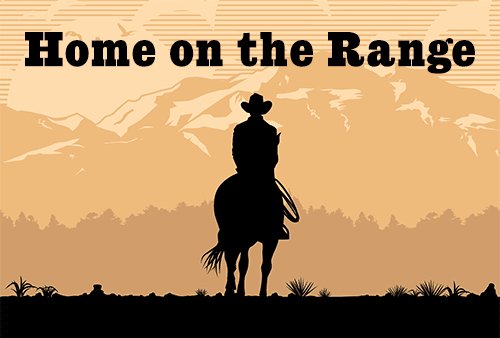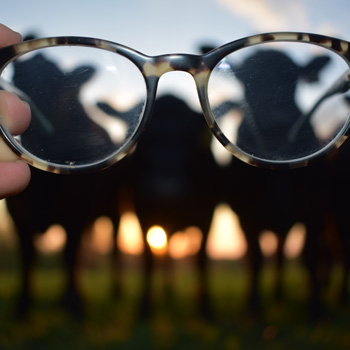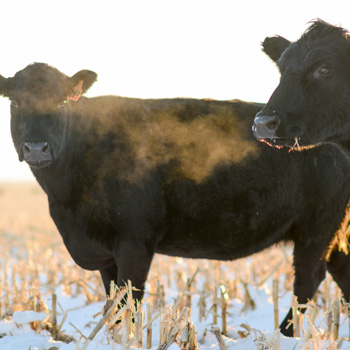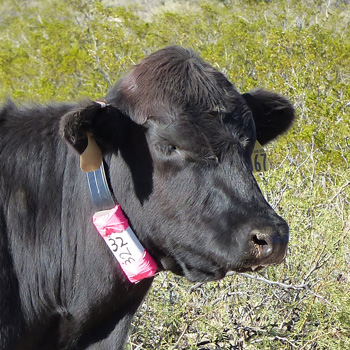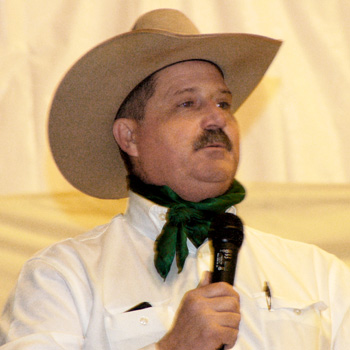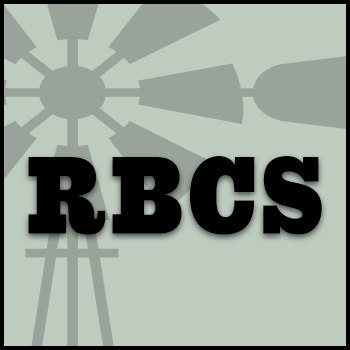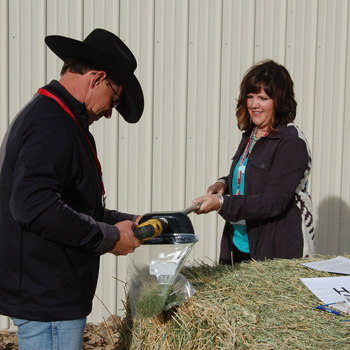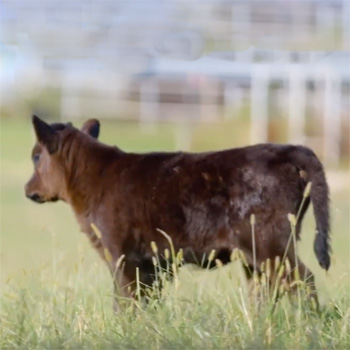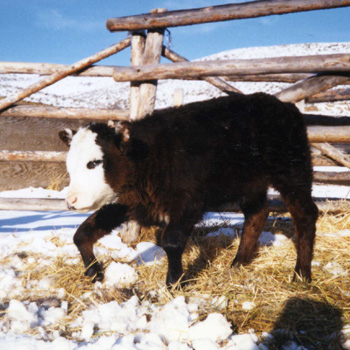Angus Advisor
Our team of Angus advisors offer regional tips for herd management for the winter season.
Southern Great Plains
david.lalman@okstate.eduMilk and energy balance
I have long been fascinated by the complexity of biological systems and the ability of animals to respond to their environment. Energy balance in a lactating cow is a great example. Beef cows are resilient. They are programmed to adjust in real time to their environment. Some cows respond better than others, often referred to as “adaptability.”
The early lactation period represents the most energetically expensive phase of the annual production cycle. For perspective, during the last trimester, a 1,300-pound (lb.) cow in good body condition requires about 3.3 megacalories of net energy for maintenance (Mcal NEm) to support her pregnancy along with 9.4 Mcal NEm for maternal tissue maintenance. Peak milk yield generally occurs 4-6 weeks after calving. Assuming average genetic potential for milk production, about 8 Mcal NEm are required to support lactation.
In addition, maintenance energy requirements increase by about 20% during lactation, resulting in maternal tissue maintenance requirements of 11.3 Mcal NEm per day. Therefore to produce 24 lb. of milk and maintain maternal tissue, about 19.3 Mcal NEm are required.
If diet quality or feed availability limit this lactating cow to lower daily energy intake for several days, two things will occur. First, average daily milk yield will decline. Milk yield is highly sensitive to energy availability. At the same time, the cow will begin to lose weight. On the other hand, in this example, if diet quality and availability allows greater than 19.3 Mcal NEm intake, milk yield will increase. Concurrently, some of the additional energy supplied will be stored as increased tissue gain.
The relative partitioning of energy gain or loss to milk and maternal tissue is complex and not well understood in beef cattle. In some of our recent work, about 55% to 60% of increased energy intake was partitioned to milk production, and the remaining 40% to 45% was partitioned to maternal tissue gain.
It is clear a genetic-by-environment interaction exists related to energy partitioning. With greater genetic potential for milk, as energy intake increases, more of the added energy will be partitioned to milk and less to maternal tissue gain. This is why trying to increase cow body condition during lactation in cows with high genetic capacity for milk is difficult and extremely expensive. The opposite scenario would be low genetic capacity for milk production. In these animals, most energy supplied beyond that required for maintenance and milk production will be stored as maternal tissue.
Increased genetic capacity for milk yield does increase forage intake. However, feed or forage intake capacity is limited. In fact, recent data suggest that each 1 lb. increase in milk production is associated with 0.2 to 0.4 lb. increase in forage intake. With this information, energy balance can be estimated.
For example, milk contains about 0.33 Mcal NEm on a wet weight basis. High-quality forage contains about 0.74 Mcal NEm per lb. dry matter (70% TDN, total digestible nutrients). In this case, each 1 lb. increase in milk yield is expected to result in about 0.22 Mcal increase in energy availability (0.74×0.3), or a slight negative energy balance (-.11 Mcal).
The lower the diet quality and the greater the increase in milk yield, the greater the negative energy balance and vice versa. The problem with estimating energy balance in a grazing system is that forage quality, forage availability and milk yield are moving targets.
In the short term, a mismatch between forage quality and milk production can be offset by providing a diet with greater energy concentration. This might be accomplished by changing calving timing or by modifying the environment with more expensive purchased or harvested feeds. The value of feeding more purchased or harvested feeds can only be determined on a case-by-case basis, and is driven by feed costs and weaned calf value. In the long term, the negative energy balance could be offset by shifting the calving season and (or) selecting animals with slightly lower genetic capacity for milk yield and leaving the diet unchanged.
Western Region
randyp@csufresno.eduFall–calving herds
Main focus: getting cows bred
Return inseminations: If you are using artificial insemination (AI) on return heats, give a gonadotropin-releasing hormone (GnRH) injection at the time of breeding as it has been proven to increase conception rates on repeat inseminations. I like to switch bulls and not breed the female back to the same AI sire that I used on the first service.
Natural-service sires: Bulls are probably already turned out or will be shortly. If females are in pastures where they are easily observed, record natural service dates and watch for return heats in cows that have been naturally covered by bulls. If a high percentage of the females that have been naturally covered by bulls are coming back into estrus, replace the bull if that is an option.
Mineral supplementation: Mineral supplementation is important in achieving optimal reproductive performance. The breeding season is the most critical period to be certain females are achieving adequate mineral consumption.
Protein and energy supplementation: It is critical protein and energy requirements of females are being met during breeding season. Females should be in a positive energy balance or gaining weight during the breeding season as energy balance has a significant influence on fertility or conception rate.
Vaccinations: Calves should receive their first round of vaccinations. Producers should consult with their veterinarian in developing a vaccination protocol. I recommend calves are at least 45 to 60 days old before receiving their first round of vaccinations. This can cause a problem if you have some late clean-up-sired calves. In these situations, I like to vaccinate the AI-sired calves about 30 days before the clean-up sired calves. In many operations, this practice may not be practical.
Bottom-end bull calves: Calves should be old enough by now to identify the bottom end of bull calves. I recommend producers look at bull calves with a critical eye and a sharp knife. In most herds I think the bottom 20% of the bull calves should be castrated, and this should be determined based on phenotypic quality only.
Spring–calving herds
Main focus: the calving season
Calving supplies: Supplies should be on hand, and proper equipment should be available to assist females with problems at calving. Be sure personnel are properly trained in the most current procedures recommended for assisting females experiencing calving difficulties.
Colostrum: In order for maximal absorption of maternal antibodies, calves should nurse within the first 6 hours after birth. A frozen colostrum supply could be kept on hand or a colostrum replacement or supplement could be used. Extra milk from a mature cow taken shortly after calving is the best source of frozen colostrum.
Retained placentas: Watch for retained placentas and treat those cows promptly. If the cows have not cleaned by 24 hours, we first administer a prostaglandin injection. If they don’t clean in response to that injection, then we administer another prostaglandin injection combined with a treatment of antibiotics either given intramuscular (IM) or mixed with sterile water and infused directly into the uterus.
Body condition score: The target body condition score (BCS) at calving is 5.0 (scale = 1 to 9) for mature cows and 6.0 for 2-year-old heifers. Both protein and energy requirements need to be met in order to achieve the desired level of body condition.
Bull and heifer development: Both bulls and heifers should be performing at levels that will allow achieving desired average yearling weights. Our target levels of performance here at the university when developing bulls and heifers from weaning to yearling are 3.0 to 3.5 lb. per day for bulls and 1.0 to 1.5 lb. per day for heifers.
Treatment protocols: Have treatment protocols and products on hand for both scours and pneumonia.
Southeast Region
jduggin@uga.eduA fresh beginning, or hitting the mental reset button, is a helpful way to get motivated for the coming year. Recently, I worked with a new cattle producer who wanted to basically start from scratch. He bought an existing herd that came with the farm he purchased. This commercial herd did not have a defined calving season and lacked genetic uniformity. His ultimate goal of selling load lots of high-quality, preconditioned calves with the existing herd looked like too long of a road.
However, as a successful businessman in another industry, he knew what it would take to achieve his goals: study and preparation. This producer routinely attends short courses, conventions and cattlemen’s meetings to help set his direction and network with other producers.
He would also vigorously read and study the industry to further prepare for obstacles ahead. One advantage he has as a new producer is that he does not have any biases. He is seeking both timeless wisdom of days gone by and incorporating that with modern management techniques and technology. He is hungry for helpful information.
First, he has put a focus on grazing management. This would be one the most helpful ways to improve overall productivity per acre, seedstock or commercial. He worked with the local Natural Resources Conservation Service (NRCS) to set up a water delivery plan and implement more crossfencing. He has also incorporated single-strand power fence to further maximize his grazing potential. The farm will go from four pastures to more than 10. The producer is also looking at using some novel-endophyte fescue varieties in a few smaller paddocks. He realizes the issues associated with tall fescue in the East, and is strategically going to minimize the effects of toxic endophytes during the spring and summer as he plans for spring calving.
Next, we developed a plan for what type of females would best fit his environment and goals. Some selection factors included a maximum mature weight, foot quality, maternal look, fleshing ability and proven parental lines from a reputable producer.
After four months of searching for the right cattle to meet his goals, he purchased 50 head of bred heifers all due to calve at the same AI date. This will be the base herd to develop his eventual 150 to 200 head.
When we have been in the cattle business for our entire lives, there is a tendency to get tunnel vision. Building relationships with veterinarians, breed field representatives, extension and other cattlemen can be helpful if we are willing to listen to sound advice. A fresh look at our operations with an open mind may just be the necessary ingredient to help us get through the difficult times and give us a leg up when the doors of opportunity open.
Midwest Region
baileyeric@missouri.eduThe idea of “new beginnings” brings to mind a concept that beef producers do not utilize enough. Successful cow-calf operations have incorporated flexible grazing units into their grazing plan. Flexible grazing units are cattle easily marketed. Retain calves after weaning to gain these flexible cattle grazing units.
The ranch I was raised on marketed long yearlings most years. This meant fewer cows than the land could have supported, but more valuable calves at sale. Calves grazed dormant range over the winter, continued to graze through spring, and were marketed in July the following year.
Here is the important concept: We were not set on selling a 900-lb. steer in July. If forage availability was a problem, we sold calves and reduced mouths to feed. We did not feed calves purchased or raised feeds.
A drag on cow-calf profitability is selective overstocking. This occurs when forage demand and forage availability only match up sporadically. By retaining calves after weaning, you now have the ability to reduce feed needs during times of shortages.
Reducing cow numbers and growing calves after weaning can also generate additional dollars. If cows go into calving and breeding seasons in better body condition, they are more likely to rebreed and calve early in the subsequent calving season. Calving early in the season is an important component of cow longevity.
The key to making a profit on calves is to consider the value of weight gained. Price slides at marketing reduce the value of weight gain. There are too many variables to give a rule of thumb, but keep in mind that producers sending calves to grow on other operations are expecting the cost of weight gain to be around $0.60 per lb. To make money by growing calves, a cheap feed source is necessary. I highly recommend stockpiled tall fescue in Missouri.
Remember, the best managers do not make the most money in the good years. They lose the least money in the bad years. Please let me know if I can help you work through incorporating growing calves into your cow-calf operation.
